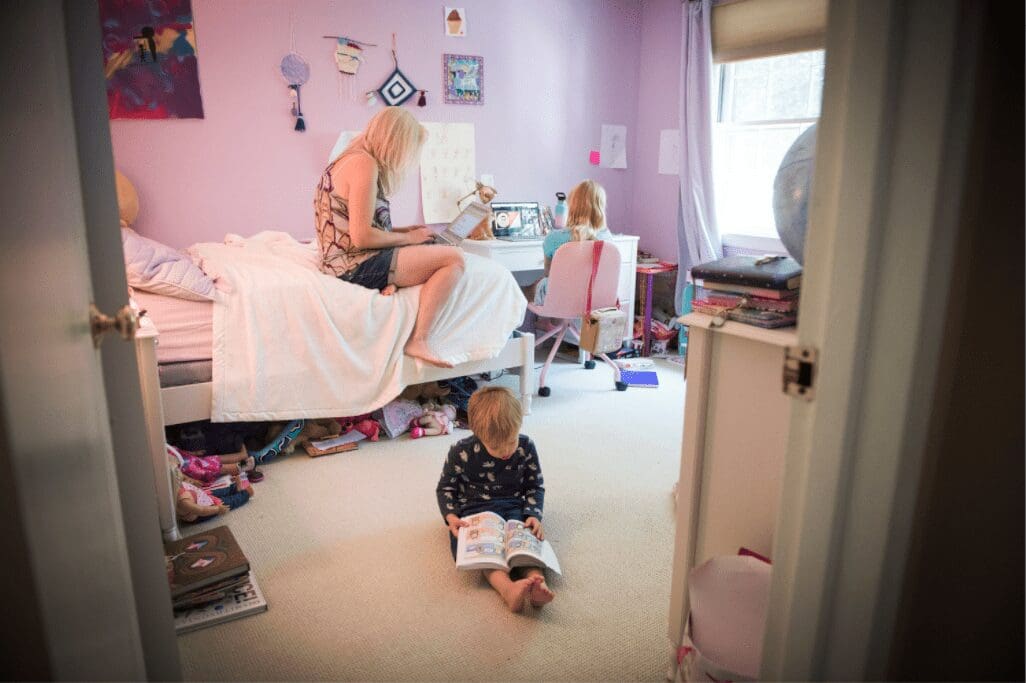Pandemic parenting is impossible. American work culture is a big reason why.
By Anna North
Erica, an Indiana mom, was working part time last spring as a computer scientist. At the same time, she was taking care of her first-grader, preschooler, and toddler at home, with schools and day care centers in the area shuttered due to the pandemic.
During one of her work shifts, she was nursing her toddler while trying to read at her desk, “and he swung his leg, and it somehow landed in my tea, and it kicked the teacup over,” she told sociologist Jessica Calarco and her team as part of a study of pandemic parenting. “Tea all over both of us, all over the desk, all over the chair, all over the wall, and then he bit me at the same time.”
It’s a scene likely all too familiar to the millions of parents still trying to work while caring for children as the Covid-19 pandemic hits the one-year mark. Erica’s husband, an office manager, also worked from home, but his job “is very demanding,” she told Calarco’s team.
“They talk a lot about flexibility, but at the end of the day, if [his boss] sets a meeting, he sets a meeting. You can’t not go, even during a pandemic.”
Stories like this — about moms trying to manage everything during a seemingly endless public health crisis — have prompted many necessary conversations about America’s failure to invest in child care and the stubborn gender inequity in many American families.
But there’s another issue that the pandemic has laid bare perhaps more starkly than ever before: the problem of work.
Long before Covid-19 hit, Americans were expected to work like they didn’t have families. Some call it the myth of the “ideal worker” — the idea that the perfect employee is someone “unencumbered by any other problem other than your job,” Andrea Rees Davies, associate director of the Stanford Humanities Center and a historian who has worked on gender in the workplace, told Vox.
That ideal was unrealistic long before the pandemic, for parents and non-parents alike, but add in the demands of taking care of kids with schools and day cares closed, and a bad situation has become unbearable for many — and yet they’re somehow bearing it.
The result is burnout, with 91 percent of moms reporting more exhaustion than before the pandemic (along with 35 percent of dads), according to a December survey by Calarco.
While there has been much discourse around burnout, and much evidence of kids popping in on Zoom calls, all this visibility hasn’t necessarily led to employers changing their demands on workers: Americans are actually working more hours per day on average now than when the pandemic began. And experts say it’s not enough for companies to just be okay with kids making an appearance during a meeting— they need to make real changes like hiring more employees and reducing hours so that people actually have time to tend to their lives. Meanwhile, policymakers need to consider reforms from paid family leave to universal basic income that would make it possible for everyone to meet their needs.
Overall, it’s long past time for the idea of the “ideal worker” to retire.
For generations, Americans have been expected to work like they didn’t have families
Work itself has changed a lot in recent decades, as automation transformed factories and the laptop and smartphone made every couch and kitchen table a potential office.
But American ideas about work and workers haven’t changed as much — they still have their roots in the years after World War II.
The war had brought an influx of women into the workplace, but when it was over, many were forced out to make room for returning men. With the end of the war came the rise of a type of work reserved almost exclusively for white men, Davies said: corporate jobs in offices where loyalty to a company was rewarded with job security, promotions, and raises.
This was the time of the growth of suburbs — which often specifically excluded Black families — and of the midcentury ideal of white middle- and upper-middle-class life depicted on Mad Men.
As Davies put it, “you have this beautiful home, and the white picket fence, and 2.2 kids, and the husband’s on the train to the office.”
This version of the American dream, however, came at a cost — that husband was supposed to be available to his job from 9 to 5, five days a week, without any child care or other responsibilities, because his wife was handling everything on the home front, Davies explained.

Madison Avenue advertising executives work on a project in New York City, circa 1950. 
A Madison Avenue advertising executive makes a client visit in New York City, circa 1950.
It was also around this time that the 40-hour workweek became part of American labor law. Previously, workweeks in many jobs were much longer — but even though 40 hours was an improvement, it wasn’t based on what actually made sense for people with families or other responsibilities outside work.
Instead, it was based on the idea that “the worker was a man and that the worker had a woman who was doing the reproductive labor in the home full time,” Kathi Weeks, a feminist political theorist and the author of the book The Problem with Work, told Vox.
This wasn’t true even at the time, of course — not for people of color, and not for most working-class families. But the fiction of a woman at home taking care of kids and other family members was the only way to make the idea of a 40-hour workweek tenable. “If every worker was imagined to be doing all of this labor of caring for children and the elderly,” Weeks said, policymakers “wouldn’t have imagined that 40 hours a week is a reasonable standard of full time.”
Untenable as it was, the 40-hour workweek just got longer as time went on. With the advent of technologies like smartphones and email, 9 to 5 became 24/7 — the ideal worker was available “any time, day or night,” Davies said, still with no family obligations or anything to distract from their “single-minded devotion to the employer.”
Today, the average American works more hours in a year than the average worker in any other similarly wealthy nation.
:no_upscale()/cdn.vox-cdn.com/uploads/chorus_asset/file/22363707/GettyImages_1254842406.jpg)
And that ideal didn’t change when more women started entering corporate jobs, making families with two working parents more common across the middle class. Workers were still expected to give everything to work and to keep their families largely invisible — which led to high levels of stress, especially among working moms, long before the pandemic began.
Meanwhile, someone still had to take care of the kids. But care work in America had been devalued long before the men came home from World War II. That history goes back to slavery, when “the original caregivers were enslaved Black women who took care of landowners’ children,” Rakeen Mabud, senior director of research and strategy for Time’s Up, told Vox.
“That’s the very root of why we think about that kind of labor, and the labor performed by Black women in particular, as undeserving.”
And even into the 20th and 21st centuries, efforts to create a universal child care system in America — which could also be used to help caregivers make a living wage — have been stymied by the idea that care isn’t or shouldn’t be real, compensated work. For example, in 1971, President Richard Nixon vetoed a bill that would have created a nationwide child care program because he “deemed caregiving labor as something that should be the responsibility of families,” Mabud said.
The result has been that child care workers — the majority of whom are women, and about 40 percent of whom are women of color — often make poverty-level wages, an average of around $11 an hour. They are also disproportionately likely to lack health insurance, paid sick leave, and other benefits. And yet they often work 10-hour days or even longer to keep up with the demands of parents’ work schedules.
In essence, child care workers shoulder all the burdens of the ideal worker myth but get none of the benefits.
That didn’t work before the pandemic. It really doesn’t work now.
And that was before the pandemic hit. In spring 2020, schools in all 50 states closed their buildings in an effort to stem the spread of the novel coronavirus, and many day care centers shut down as well. For child care workers, this meant layoffs — by July 2020, 258,000 had lost their jobs. And for many working parents, it meant figuring out how to balance the new demands of full-time care and remote school with the old demand that they work as though their kids didn’t exist.
If you’re a parent, or if you even know one, you know how that’s going. Simply put, “people aren’t managing,” Mabud said.
Parents who are able to work from home are often in some version of the situation Gina, an Indiana mom, described to Calarco’s team.
“Somehow I’m not getting any work done, but also [my daughter] is not getting the best mothering she could be getting,” she said.
“It’s like, wait a second. Where did all that energy go, if it’s not going into work and not going into her? All of a sudden I’m not doing a good job of either.”
But pushing back on work hours often doesn’t feel like an option, especially during a pandemic and economic crisis during which millions have lost their jobs. In Calarco’s research, if moms did cut back on work hours, it was often so that dads could work more.
Especially with the “fear of losing a job in the midst of a pandemic,” Calarco said, “many families, especially if dad is already earning more than mom, are going to sacrifice mom’s job to make sure that dad is able to lock himself in his bedroom all day and work without disruption.”
That tells us something about the gender pay gap and the fact that moms still do the majority of child care in American families. But it also tells us something about employers — that working without disruption is still something they expect, a year into a pandemic, and families are simply supposed to figure out a way to make it happen.
That expectation is taking a psychological toll, with 41 percent of parents in Calarco’s December survey reporting increases in depression since the pandemic started, and 43 percent reporting increased anxiety.
And in heterosexual, two-parent families, moms are typically bearing the brunt of the family demands ushered in by the pandemic, with 80 percent of mothers of kids under 12 saying they handled the majority of homeschooling in one April survey.
But not every parent has the ability to work from home and manage homeschooling. For parents working in-person during the pandemic, work comes with the fear of bringing Covid-19 home to children and other loved ones.
“Now that we’ve got showers at work, I at least can shower before I come home and pick up [my daughter],” Jillian, an ICU nurse in Indiana, told Calarco’s team. “Because before, it was like, ‘I don’t want to really pick you up here right now.’”
:no_upscale()/cdn.vox-cdn.com/uploads/chorus_asset/file/22363743/GettyImages_1215614329.jpg)
And while some in-person workers have been able to get child care, either using programs for essential workers or relying on family or friends, others have had to quit or scale back at work, sometimes jeopardizing their families’ finances. For example, in a survey conducted in the fall of 2020 by Time’s Up, Color of Change, and other groups, 52 percent of Latina women and 44 percent of Black women said that their care responsibilities would limit the amount of paid work they were able to do for the remainder of 2020. Meanwhile, 34 percent of white women and 26 percent of white men said the same.
There have been some efforts to help parents. For example, federal Covid-19 relief legislation in March 2020 provided 10 weeks of paid leave to parents affected by school or day care closures. But there were huge loopholes, allowing small as well as large businesses to get around the requirements and leaving millions of people without paid time off.
And workers of color were especially likely to be denied access to leave: In the Time’s Up survey, 28 percent of Black workers said their requests for paid sick or family leave during the pandemic had been denied, compared with 9 percent of white workers.
In the absence of paid leave, some workplaces — especially those where employees could work remotely — offered flexibility, letting workers complete their tasks outside normal work hours so they could take care of kids. But in practice, that “often means pushing work to 10 pm to midnight or to 4-6 am,” cutting into parents’ time for sleep, exercise, or just doing things they enjoy, Calarco said. “Flexibility right now is helpful, but it’s not necessarily enough on its own.”
The country needs to transform its relationship to work
What is needed, many say, is a full reimagining of the way America views work and workers.
The first and most basic step is paid leave. The pandemic has shown what should have been clear all along: that giving workers time off when they are sick or need to care for loved ones is not just a public good but a “moral imperative,” as Mabud puts it.
“What we choose to invest in as a society tells a lot about who and what we value collectively,” she explained, “and when you’re telling someone, you have to come into work when you’re sick, we’re also saying that we don’t think your sickness actually matters that much.”
Another critical piece is building a national child care infrastructure that not only makes care affordable, but ensures that care workers get good wages and benefits. Investing in such a system would help not just care workers, but also many low-wage working parents — many of them women of color — who struggle to pay for care today, when day care can often cost more than college tuition. “We think about demand and supply of care as two separate things,” Mabud said, but “they’re one and the same.”
:no_upscale()/cdn.vox-cdn.com/uploads/chorus_asset/file/22363777/GettyImages_1231648292.jpg)
“My ability to go to work is dependent on my ability to make sure that I can take care of these other responsibilities,” she explained. “We all are better off when the people providing care are paid well.”
Beyond these policy reforms, there’s also a larger need to question the role work plays — and the space it takes up — in American lives. “We have to really start talking about shorter hours,” Weeks said. The work of caring for a family “is just massive and it was already impossible to combine with full-time work” well before the pandemic began.
Another way to rethink the volume of work Americans do is by pressuring companies to simply hire more people. Rather than asking parents, for example, to get their work done between 10 pm and midnight, employers could hire additional staff so that “some workers can take on more or take on less depending on what’s going on with them in their lives,” Calarco said.
“Our culture has been moving increasingly toward overwork for the past few decades,” she explained. “This is a moment where we need to be rethinking that.”
And beyond rethinking individual jobs, many have called for a universal basic income so that wage work isn’t the only way for people to meet their needs. “I think it’s the only rational option once you realize that wage work as a system of income allocation is not working,” Weeks said. “There’s just not enough work, and not enough work at living wages, to go around.”
It’s an idea that’s gained traction in the US and around the world during the pandemic, with San Francisco starting a pilot program and Germany and Austria experimenting with the idea as well. The concept raises important questions around “what is work, what should be considered work, and how do we value the things that are currently not considered work in our collective well-being,” Mabud said.
Indeed, the pandemic as a whole has sparked new conversations about the role of wage work in American lives. The very idea of “essential workers” has provided an opening to talk about the true purpose of work. Does the country truly need, for example, all the various products that people have risked their health and safety to produce and deliver in the past year?
“We rarely talk about, what are you producing at work, is that valuable?” Weeks said. “This whole notion of ‘essential’ and ‘inessential’ workers is an opening to ask some difficult questions about what we’re toiling away our lives in order to accomplish.”
These kinds of deep questions haven’t necessarily reached a lot of American workplaces. Too many workers still find themselves in the same situation as Erica and her husband, with meetings that keep marching on, pandemic or no. But the crisis of the past year may finally have provided an opening, no matter how small, for change.
The pandemic “reveals all the cracks in the system,” Mabud said. “It shows us that we are all dependent on each other.”
_____
To see original article please visit: https://www.vox.com/22321909/covid-19-pandemic-school-work-parents-remote











:no_upscale()/cdn.vox-cdn.com/uploads/chorus_asset/file/22363692/GettyImages_167282756.jpg)









